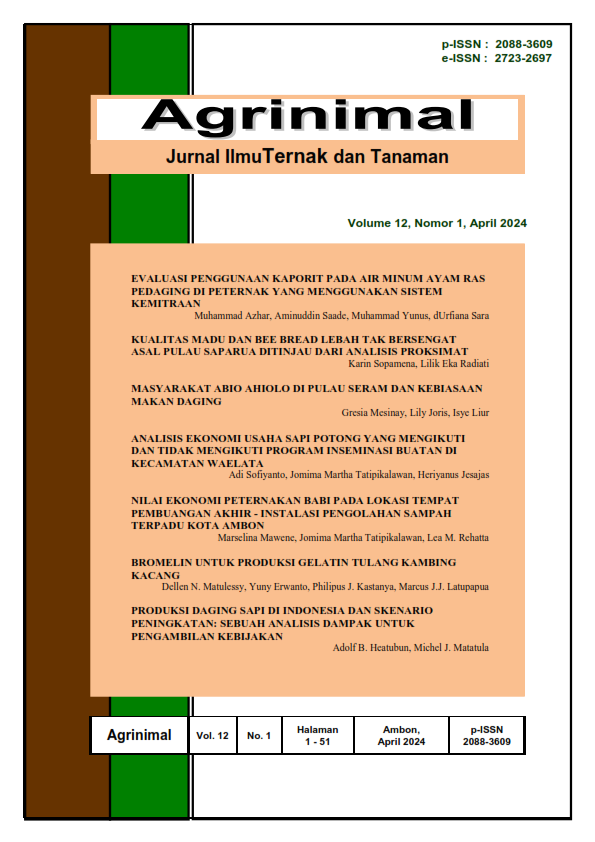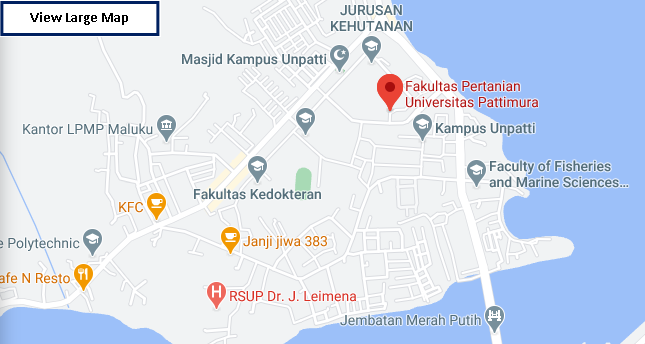EVALUASI PENGGUNAAN KAPORIT PADA AIR MINUM AYAM RAS PEDAGING DI PETERNAK YANG MENGGUNAKAN SISTEM KEMITRAAN
EVALUATION OF THE USE OF CHLORINE IN THE DRINKING WATER OF BROILERS IN THE FARMERS-BY-PARTNERSHIP SYSTEM
Abstract
Proses klorinasi air minum menjadi standar pemeliharaan ayam ras pedaging modern, namun pada aplikasi level peternak (mitra perusahaan) proses klorinasi tidak terkontrol baik. Penelitian ini bertujuan untuk mengetahui konsentrasi penggunaan klorin pada air minum ayam ras pedaging, hubungannya dengan produktivitas, dan faktor-faktor yang mempengaruhi konsentrasi klorin pada air minum tersebut. Pengambilan data dilakukan pada 90 unit kandang ayam ras pedaging di Kecamatan Ponre Kabupaten Bone Provinsi Sulawesi Selatan. Pengambilan data dilakukan secara langsung dengan mengukur konsentrasi klorin dan pH air minum ayam ras pedaging menggunakan alat CL2 Chlorine Tester. Suhu dan kelembaban diukur menggunakan Thermo Hygrometer DT-3 Elitech. Produktifitas ayam ras pedaging dihitung dari percatatan pemeliharaan peternak setiap unit kandang. Data yang diperoleh dianalisis korelasi dan regresi linear berganda. Hasil penelitian menunjukkan 74,44% kandang ayam ras pedaging di Kecamatan Ponre memiliki konsentrasi klorin air minum yang tidak sesuai dengan rekomendasi. Konsentrasi klorin memiliki korelasi yang kuat dengan pH air minum, persentase afkir, persentase deplesi, konsumsi pakan, dan konversi pakan. Semakin tinggi suhu dan kelembaban, maka semakin tinggi konsentrasi klorin. Level teknologi instalasi air yang diterapkan peternak yang semakin rendah, maka konsentrasi klorin semakin tinggi secara parsial dan simultan dengan persamaan regresi Cl = 4,136 + 0,153 Suhu + 0,030 Kelembaban – 2,036 Instalasi Air.
ABSTRACT
The drinking water chlorination process has become the standard for raising modern broilers, but at the farmer (company partner) level application, the chlorination process is not well controlled. This study aims to determine the concentration of chlorine used in drinking water for broilers, its relationship with productivity, and the factors that influence the concentration of chlorine in drinking water. Data collection was carried out in 90 units of broiler cages in Ponre District Bone Regency South Sulawesi Province. Data collection was carried out directly by measuring the chlorine concentration and pH of drinking water for broilers using the CL2 Chlorine Tester. Temperature and humidity were measured using an Elitech DT-3 Thermo Hygrometer. The productivity of the broiler is calculated from the farmer's maintenance records for each cage unit. The data obtained were analyzed for correlation and multiple linear regression. The research results showed that 74.44% of broiler cages in Ponre District had drinking water chlorine concentrations that did not comply with recommendations. Chlorine concentration has a strong correlation with drinking water pH, removal percentage, depletion percentage, feed consumption, and feed conversion. The higher the temperature and humidity, the higher the chlorine concentration. The lower the level of water installation technology applied by farmers, the higher the chlorine concentration will be, partially and simultaneously with the regression equation Cl = 4.136 + 0.153 Temperature + 0.030 Humidity – 2.036 Water Installation.
Downloads
References
Averós, X., & Estevez, I. (2018). Meta-Analysis of the Effects of Intensive Rearing Environments on the Performance and Welfare of Broiler Chickens. Poultry Science, 97(11), 3767–3785. https://doi.org/10.3382/ps/pey243.
Boxall, N.S., Perkins, N.R., Marks, D., Jones, B., Fenwick, S. G., & Davies, P. R. (2003). Free Available Chlorine in Commercial Broiler Chicken Dringking Water in New Zealand. Journal of Food Protection, 66(11), 2164-2167. https://doi.org/10.4315/0362-028X-66.11.2164.
Di Martino, G., Piccirillo, A., Giacomelli, M., Comin, D., Gallina, A., Capello, K., Buniolo, F., Montesissa, C., & Bonfanti, L. (2018). Microbiological, Chemical and Physical Quality of Drinking Water for Commercial Turkeys: A Cross-Sectional Study. Poultry Science, 97(8), 2880–2886. https://doi.org/10.3382/ps/pey130.
Do Amaral, A.L. (2004). Drinking Water as a Risk Factor to Poultry Health. Brazilian Journal of Poultry Science. 6(4), 191-199. https://doi.org/10.1590/S1516-635X204004001.
Farhadi, D., & Hosseini, S. M. (2014). Comparison of Broiler Performance in Two Conventional and Environmentally Controlled Modern Broiler Houses in Tropics. Global Journal of Animal Scientific Research, 2(3), 190–196.
García-Ávila, F., Sánchez-Alvarracín, C., Cadme-Galabay, M., Conchado-Martínez, J., García-Mera, G., & Zhindón-Arévalo, C. (2020). Relationship between Chlorine Decay and Temperature in the Drinking Water. MethodsX, 7. https://doi.org/10.1016/j.mex.2020.101002.
Gulizia, J. P., Rueda, M. S., Ovi, F. K., Bonilla, S. M., Prasad, R., Jackson, M. E., Gutierrez, O., & Pacheco, W. J. (2022). Evaluate the effect of a commercial heat stable phytase on broiler performance, tibia ash, and mineral excretion from 1 to 49 days of age assessed using nutrient reduced diets. Journal of Applied Poultry Research, 31(3). https://doi.org/10.1016/j.japr.2022.100276.
Horhoruw, W. M. & Rajab. (2019). Bobot Potong, Karkas, Giblet Dan Lemak Abdominal Ayam Broiler Yang Diberi Gula Merah Dan Kunyit Dalam Air Minum Sebagai Feed Additive. Agrinimal Jurnal Ilmu Ternak dan Tanaman, 7(2), 53-58. https://doi.org/10.30598/ajitt.2019.7.2.53-58.
Jacobs, L., Persia, M. E., Siman-Tov, N., McCoy, J., Ahmad, M., Lyman, J., & Good, L. (2020). Impact of water sanitation on broiler chicken production and welfare parameters. Journal of Applied Poultry Research, 29(1), 258–268. https://doi.org/10.1016/j.japr.2019.10.013.
Lima, K. A. O., Nääs, I. A., Moura, D. J., Garcia, R. G., & Mendes, A. S. (2021). Applying multi-criteria analysis to select the most appropriate broiler rearing environment. Information Processing in Agriculture, 8(2), 205–218. https://doi.org/10.1016/j.inpa.2020.04.007.
Llonch, L., Verdú, M., Martí, S., Medinyà, C., Riera, J., Cucurull, J., & Devant, M. (2023). Drinking water chlorination in dairy beef fattening bulls: water quality, potential hazards, apparent total tract digestibility, and growth performance. Animal, 17(1). https://doi.org/10.1016/j.animal.2022.100685.
Mahmoudi, S., Mahmoudi, N., Benamirouche, K., Estévez, M., Mustapha, M. A., Bougoutaia, K., & Djoudi, N. E. H. Ben. (2022). Effect of feeding carob (Ceratonia siliqua L.) pulp powder to broiler chicken on growth performance, intestinal microbiota, carcass traits, and meat quality. Poultry Science, 101(12). https://doi.org/10.1016/j.psj.2022.102186.
Meng, W. S., Sui, X., Xiao, Y., Zou, Q., Cui, Y., Wang, T., Chen, Z., & Li, D. (2023). Regulating effects of chlorinated drinking water on cecal microbiota of broiler chicks. Poultry Science, 102(12).https://doi.org/10.1016/j.psj.2023.103140.
Najjar, M. B., & Meng, J. (2009). Risk Assessment of Disinfection Byproducts in Poultry Chilled in Chlorinated Water. Joint Institute for Food Safety and Nutrition and Department of Nutrition and Food Science.
Nuryati, T. (2019). Analisis Performans Ayam Broiler Pada Kandang Tertutup dan Kandang Terbuka. Jurnal Peternakan Nusantara, 5(2), 2442-254.
Rohim, M. (2006). Analisis Penerapan Metode Kaporitisasi Sederhana Terhadap Kualitas Bakteriologis Air PMA. Disertasi. Semarang: Program Pascasarjana Universitas Diponegoro.
Rossi, A. P., Lahis Kalschne, D., Paula Iglikowski Byler, A., Lisandro de Moraes Flores, E., Donizeti Leite, O., dos Santos, D., Smanioto Barin, J., & Canan, C. (2021). Effect of ultrasound and chlorine dioxide on Salmonella Typhimurium and Escherichia coli inactivation in poultry chiller tank water. Ultrasonics Sonochemistry, 80. https://doi.org/10.1016/j.ultsonch.2021.105815.
Riyanti, F., Puji, L. & Afrilianza. (2010). Proses Klorinasi untuk Menurunkan Kandungan Sianida dan Nilai KOK pada Limbah Cair Tepung Tapioka. Jurnal Penelitian Sains, 13(3), 34-39.
Schneider, A. F., Almeida, D. S., Moraes, A. N., Picinin, L. C. A., Oliveira, V., & Gewehr, C. E. (2016). Chlorinated drinking water for lightweight laying hens. Arquivo Brasileiro de Medicina Veterinaria e Zootecnia, 68(6), 1690–1696. https://doi.org/10.1590/1678-4162-8795
Setiaji, A., Nurfaizin, Ma’rifah, B., & Krismiyanto, L. (2021). Mortalitas dan bobot badan tiga strain ayam broiler pada kepadatan kandang yang berbeda. Jurnal Ilmu Peternakan Terapan, 5(1), 13–18. https://doi.org/10.25047/jipt.v5i1.2779
Sugiyono. (2013). Metode Penelitian Kuantitatif Kualitatif dan R&D. Bandung: Alfabeta.
Torrey, S., Mohammadigheisar, M., Nascimento dos Santos, M., Rothschild, D., Dawson, L. C., Liu, Z., Kiarie, E. G., Edwards, A. M., Mandell, I., Karrow, N., Tulpan, D., & Widowski, T. M. (2021). In pursuit of a better broiler: growth, efficiency, and mortality of 16 strains of broiler chickens. Poultry Science, 100(3). https://doi.org/10.1016/j.psj.2020.12.052.
Toson, E., Abd El Latif, M., Mohamed, A., Gazwi, H. S. S., Saleh, M., Kokoszynski, D., Elnesr, S. S., Hozzein, W. N., Wadaan, M. A. M., & Elwan, H. (2023). Efficacy of licorice extract on the growth performance, carcass characteristics, blood indices and antioxidants capacity in broilers. Animal, 17(1). https://doi.org/10.1016/j.animal.2022.100696
Watkins, S. (2008). Water: Identifying and correcting challenges. Avian Advice, 10(3): 10–15.
Xiao, X., Bai, L., Wang, S., Liu, L., Qu, X., Zhang, J., Xiao, Y., Tang, B., Li, Y., Yang, H., & Wang, W. (2022). Chlorine Tolerance and Cross-Resistance to Antibiotics in Poultry-Associated Salmonella Isolates in China. Frontiers in Microbiology, 12. https://doi.org/10.3389/fmicb.2021.833743.








